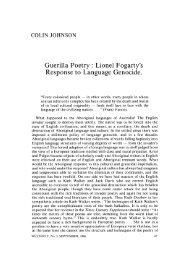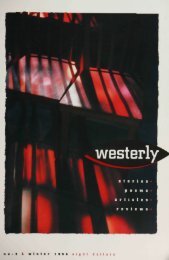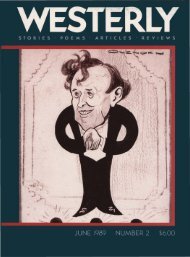You also want an ePaper? Increase the reach of your titles
YUMPU automatically turns print PDFs into web optimized ePapers that Google loves.
ON AUGUSTE RODINEric G. SaintThe exhibition The Sculpture of Rodin andhis Contemporaries, arranged by courtesy ofthe Peter Stuyvesant Trust, began its Australiantour at the State Art Gallery in Perth inOctober, and this first showing was opened byProfessor Eric Saint, Professor of Medicine inthe University of Western Australia. <strong>Westerly</strong>has pleasure in printing the text of ProfessorSaint's occasional address.This splendid exhibition of bronze remindsus of two things: of a half-forgotten traditionin the arts in the western world, and of anintrinsic weakness, feebleness in the conditionof our contemporary earthly life. In Greek,Etruscan, and Roman civilisation the plastic,kinetic art of sculpture blossomed to an extentand a degree that continues to capture ourimagination and to appeal to our sensibilities,and throughout the Gothic period geometricform and design seemed to dominate artisticconsciousness. But since the Renaissance, at allevents in northern Europe, the sculptor hasbeen forced to take a back seat among theMuses: the painter, the poet, and the composerhave been the principal architects of themodern tradition of European civilisation. Itis indeed a little surprising that the two-dimensionaltones of art and the sound of speech andmusic should have dominated our senses, overshadowinga more ancient appeal, for was notthe greatest artist of all, Michaelangelo, whoyou may say helped to create the modernimage of man, equally at home in all spatialdimensions? Thus, we approach sculpture withweakly developed critical sensibilities; and thus,for some of the artists shown in this exhibition,Renoir and Daumier perhaps best known, workwith bronze or marble was but a second choice.And with regard to our feebleness this remindsus abruptly of our willingness to compromise.In politics compromise may be avirtue, but in matters of taste it is offensive.Much of our architecture is an ugly compromisebetween form and function; as betweenthe preservation of natural beauty and demandsmade by road engineers unsatisfactorycompromises are achieved; and what we arepleased to call "pop art" is a compromise betweenthe sincerity and tradition of art and ourthird-rate admass tastes. In this environment ofcompromise in taste and form it needs fromtime to time an Auguste Rodin to remind usof our heritage. For of Rodin it was said thathe was the true successor to Michaelangelo;and Rodin himself said that he could notadmit of the existence of ugliness; he also saidthat he was like the Roman singer who repliedto the yells of the mob "Equitibas cano"—"Ionly sing for the knights": he spoke with theannoyance of the artist, and hoped that hewould be judged by men possessing an aesthetictaste similar to his own. We take Rodin as aninspired representative of that civihsation, Parisof the nineteenth century, which regarded compromisein taste as something despicable, anunforgivable weakness.What manner of man was this, who has beendescribed as the progenitor of modern sculpture?It is said that he had a big head and alarge nose—is there perhaps a hint of self caricaturein the craggy portrayal of the author ofthe Comedie Humaine?—and a flowing beardand rolling gait. He was shy and nervous inmanner and had, we are told, bright and alerteyes. He was oblivious to controversy (theBalzac furore troubled him not at all) and indifferentto honours (but he was buried by hisgrateful compatriots in an Oxonian gown andhood). He was humble, not forgetful of hisproletarian origins in the Quartier Latin, norof the early years spent as a craft mason andgoldsmith. He was a loving man, devoted to asister and to a wife who survived with him intothe first world war. He was devout: he wouldhave entered an order—but the fathers andbrothers of the Monastery of the Edistes tactfullyand gently indicated that signs of gracewould best be expressed in the studio ratherthan in the chapel. He travelled modestly,briefly to Italy, to Rome, Florence, and Venice,and more extensively to the great cathedrals ofFrance. His taste was austere, and although weshould say that none of his art was derivative,he himself came to admit that his muse owedmuch to classical Hellenic influence—"Age ofBrass", his first imaginative study, shows a perfectlyproportioned youth, conceived in theclassical manner, with arms outstretched, eagerto embrace life and experience—and much toGothic influences: "the Cathedral", "the Handof God" are redolent of that love for the devotionalart of the early church.A simple and quiet man, then, one whoselife was characterised by earnest devotion to acraft and to an art; but what supreme insighthe brought to bear on the human condition,and how versatile and catholic was his tasteand feeling! In quiet moods he notes the essential,the sometimes incredible beauty of thehuman form, the cast of a chin, the angle of anose, the noble recession of the forehead, thefirm and fruitful shape of a female torso, thetapering shape of fingers: how these simpleaspects of beauty can be used to convey theWESTERLY, No. 1 of 1967 65







